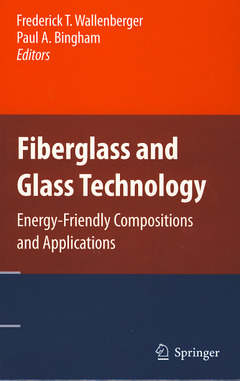Description
Fiberglass and Glass Technology, 2010
Energy-Friendly Compositions and Applications
Coordinators: Wallenberger Frederick T., Bingham Paul A.
Language: English
Subjects for Fiberglass and Glass Technology:
Keywords
Glas; composite; dynamics; glass; optical glass fibers; structural glass fibers
Support: Print on demand
Description
/li>Contents
/li>Biography
/li>Comment
/li>
Fiberglass and Glass Technology: Energy-Friendly Compositions and Applications provides a detailed overview of fiber, float and container glass technology with special emphasis on energy- and environmentally-friendly compositions, applications and manufacturing practices which have recently become available and continue to emerge. Energy-friendly compositions are variants of incumbent fiberglass and glass compositions that are obtained by the reformulation of incumbent compositions to reduce the viscosity and thereby the energy demand. Environmentally-friendly compositions are variants of incumbent fiber, float and container glass compositions that are obtained by the reformulation of incumbent compositions to reduce environmentally harmful emissions from their melts. Energy- and environmentally-friendly compositions are expected to become a key factor in the future for the fiberglass and glass industries.
This book consists of two complementary sections: continuous glass fiber technology and soda-lime-silica glass technology. Important topics covered include:
o Commercial and experimental compositions and products
o Design of energy- and environmentally-friendly compositions
o Emerging glass melting technologies including plasma melting
o Fiberglass composite design and engineering
o Emerging fiberglass applications and markets
Fiberglass and Glass Technology: Energy-Friendly Compositions and Applications is written for researchers and engineers seeking a modern understanding of glass technology and the development of future products that are more energy- and environmentally-friendly than current products.
Dr. Wallenberger completed his undergraduate studies in Chemistry at the University in Graz, Austria (1954) and pursued graduate research at Fordham University in New York, where he received his M.S. degree (1956) in pilot process research and his Ph.D. in Organic Chemistry (1958) in the chemistry of polycyclic aromatic carbon precursors. He was an Instructor in Chemistry at Fordham (1957-58) and a Research Fellow at Harvard (1958-59). He joined Du Pont Fibers, Pioneering Research Laboratory, in 1959, where he studied, for more than three decades, the relationships between structures, properties and value-in-use of new materials, and contributed to the commercialization of new fibers, polymers and composites through intrapreneurial research, project management and technology transfer. Dr. Wallenberger retired from DuPont in 1992, became a Research Professor (Materials Science) at the University of Illinois in Urbana-Champaign in 1992, a Visiting Professor (Textiles) at the University of California in Davis in 1994. He joined PPG in Pittsburgh as Staff Scientist in 1995.
Dr. Wallenberger is a fiber scientist, an expert in the fields of advanced glass, ceramic and carbon fibers, single crystal fibers, whiskers and nanotubes, natural fibers, advanced polymers and fiber-reinforced composites. He is also a specialist in technology assessment and technology transfer. At the University of Illinois, he jointly taught successive project-based team courses with a member of the business faculty on the principles of organizing new high tech businesses. At the University of California he taught textile fibers and manufacture, and a University-wide course on the benefits of plastics to the society and their impact on the environment. Between 1992 and 1995, he was a consultant and assisted entrepreneurial start-up businesses with organizational advice, business strategy and license negotiations.
Since 1957, Dr. Wallenberger has contributed 152publica

